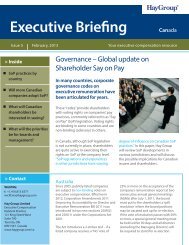Using Competencies to Identify High Performers - Hay Group
Using Competencies to Identify High Performers - Hay Group
Using Competencies to Identify High Performers - Hay Group
Create successful ePaper yourself
Turn your PDF publications into a flip-book with our unique Google optimized e-Paper software.
which a manager typically has <strong>to</strong> do. Despite this obvious mismatch, upward<br />
promotion is often seen as a just reward. The resulting failure is damaging <strong>to</strong><br />
both the new manager and <strong>to</strong> their company.<br />
<strong>Identify</strong>ing deeply rooted competencies that can most accurately determine<br />
high-potential candidates requires expertise and organizational commitment.<br />
We have seen some organizations that undertake competency studies s<strong>to</strong>p at the<br />
level of describing behavior. However, this does not give the full picture and<br />
can in fact be misleading. For behavior <strong>to</strong> be a true competency it needs <strong>to</strong> be<br />
associated with intent—the intentional use of behavior in delivering a performance<br />
outcome.<br />
In defining competencies, it is important <strong>to</strong> distinguish between two major<br />
categories:<br />
� Threshold <strong>Competencies</strong>, which are the characteristics that any jobholder<br />
needs <strong>to</strong> have <strong>to</strong> do that job effectively—but that do not distinguish the<br />
average from superior performer. For example, a good insurance salesperson<br />
must have an adequate knowledge of their products, but this is not<br />
necessarily sufficient <strong>to</strong> ensure outstanding performance.<br />
� Differentiating <strong>Competencies</strong>, which are the characteristics that superior<br />
performers have but average performers lack. For example, an insurance<br />
salesperson that is cus<strong>to</strong>mer-focused and empathetic, and can put themselves<br />
in the shoes of potential clients <strong>to</strong> really understand which products<br />
are important <strong>to</strong> them and which are not.<br />
Why Use a Competency-based Approach?<br />
A competency-based approach has as its frame of reference the performance of<br />
the very best people in the job. Organizations can improve their overall performance<br />
by hiring candidates with these competencies. They can also design<br />
highly targeted programs <strong>to</strong> develop the essential competencies that will help<br />
their average performers rise <strong>to</strong> the next level.<br />
The cost of poor selection decisions can be substantial. Consider the hard costs<br />
that go in<strong>to</strong> filling an open position, including advertising and recruitment<br />
costs, as well as candidate travel, lodging, and entertainment. Next consider the<br />
negative long-term cost implications of hiring the wrong person, including:<br />
Organizations can design<br />
highly targeted programs <strong>to</strong><br />
develop the essential<br />
competencies that will help<br />
their average performers<br />
rise <strong>to</strong> the next level.<br />
WORKING<br />
PAPER<br />
4

















